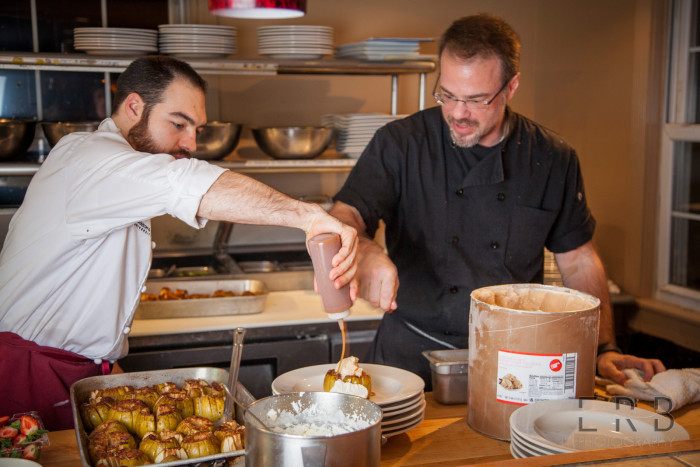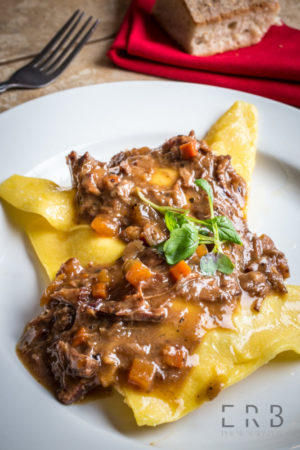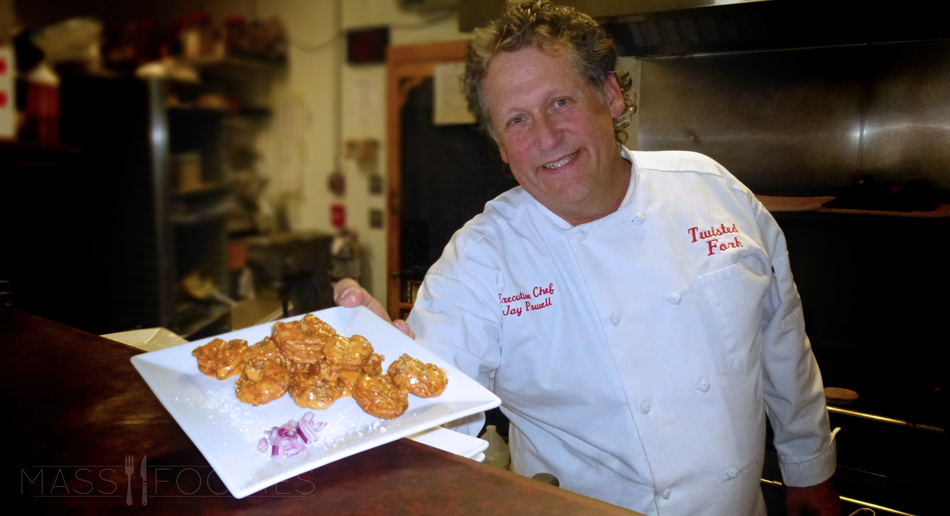
You don’t know quite what to expect when a chef cites his main influences as Jacques Pepin, Julia Child, Justin Wilson (“Cookin’ Cajun”), Martin Yan (“Yan Can Cook”), and … Chief Jay Strongbow, one of the best-known professional wrestlers of the 1970s and 80s?
Actually, it makes perfect sense if that chef is Jay Powell of The Twisted Fork Bistro. Twisted Fork bills itself as “French, Italian, and American” – and it is that. And more. A mash up of influences, ideas, and imaginings, just like Jay.
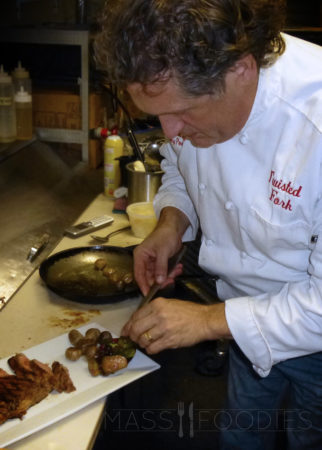 “I’ve been cooking since I was four,” Jay says. “My father would be yelling at me to go outside and mow the lawn, and I’d tell him I was watching TV. I would flip the channels between Chief Jay Strongbow donning a headdress, going on the warpath, and doing the sleeper hold and Julia Child deboning a duck or Martin Yan dicing something impossibly fast without even looking as people applauded. You gotta think people were getting drunk, decided to do that, and whacked their fingers off.”
“I’ve been cooking since I was four,” Jay says. “My father would be yelling at me to go outside and mow the lawn, and I’d tell him I was watching TV. I would flip the channels between Chief Jay Strongbow donning a headdress, going on the warpath, and doing the sleeper hold and Julia Child deboning a duck or Martin Yan dicing something impossibly fast without even looking as people applauded. You gotta think people were getting drunk, decided to do that, and whacked their fingers off.”
Jay has all of his fingers and gets plenty of applause for his food but knows he would surely get grief for political incorrectness (Strongbow was actually an Italian-American from Philly) if he decided to do an Indian war dance as he cooked. Not that you get the sense that he cares. After all, this is a guy whose Facebook page had the Abominable Snowman roasting the Elf on a Shelf on a spit and who refuses to put salt and pepper on the table during dinner service. (“I season everything. Can you please take a bite first?”)
But, still, it’s an open kitchen at Twisted Fork so no war dance, though you might think he was on one given how animated he is back there. Jay is as open and animated when it comes to his food. French, Italian, and American are really just some of the influences and he can go for high or low, which seems appropriate for a restaurant that serves most of its food in the mornings until 1 or 2pm and transforms itself into a real bistro for dinner on Fridays and Saturdays.
To emphasize this point, Jay offers me a taste of a sauce from a pan of Brussels sprouts. Sweet, tart, and warming, it is not what I expect from a master of elevated breakfast fare like portobello mushroom eggs benedict and chili omelets.
“I wasn’t going for shitty today,” Jay smiles as he sees my reaction. “I was going for good. It depends on what side of the bed I get up on. I can go for real shitty too.”
What Jay can’t go for, whether high or low cooking, is ingredients that lack a human connection. He prides himself on not just cooking from local ingredients – some of them from his own half-acre heirloom farm – but knowing the people who stand behind the food he buys regardless of where they come from: “I can tell you the person I get my food from, not just where. If I can’t source it from somebody I can talk to, I will not buy it.”
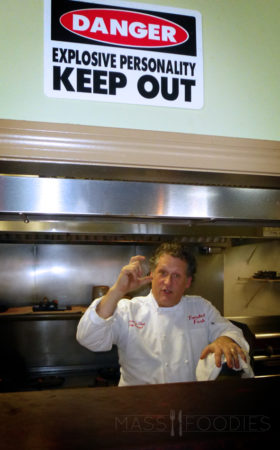
The dishes Jay puts in front of me as we talk exemplify this. Those Brussels sprouts come with cranberries from the Cape that Jay buys and freezes himself. He then braises them with apple cider and Auburn’s Pure BS Maple Shack maple syrup. They will pair with heirloom fingerling potatoes in brown butter and sage as sides for a 27-day dry-aged rib eye from Arista Beef Company in Southbridge (Jay does the aging himself). Next, a soup of tomato, mushroom, and bacon – like a pasta fajioli made from whole plum tomatoes Jay canned this fall and drizzled with his own hot sauce made from ghost chilies. He’s also making his own raviolis, today a mix of mushrooms and ricotta finished with sherry cream and homemade beef demi-glace. The marinara on that eggplant napoleon with slices of Somerville’s Fiore di Nonno mozzarella? It’s a massive hit that just joined the menu, made from scratch of course, the sauce thick, rich, and alive with fresh herbs.
Again, not what I expected when I walk into Twisted Fork. It has a familiarity and a comfort that belies its age (it opened in 2009). So does Jay’s relationship with his wife, Nancy, who does all the baking and is entrusted with prepping the restaurant’s beautiful baked beans, a secret recipe from Jay’s dad. Their easy rapport gives you the sense that they have been together decades, though they married in 2012. (She fell for him because of his signature hollandaise.)
Jay is totally good with these familiar feelings. That’s what makes him and Twisted Fork so approachable – he gives the people more than they ever thought they wanted and gets back what he wants from them.
“I want them to say, ‘Holy shit!’ when they get a plate from me,” Jay says, turning fairly Proustian. “When I cook for people, my goal is when you taste something it will evoke the memory and bring you back to your childhood, your grandparents, your aunt and uncle, your parents, or a particular situation or event. When they eat and take that first bite? That’s why I have an open window in my kitchen. I want to see their faces. I’m looking at facial reactions. I don’t just want to see if there are problems. I want to see people being blown away when they eat my food. I want them to feel like it is silly good – like they can’t figure out what is going on. I know at that point I have done my job and exactly what I was put on this earth to do.”
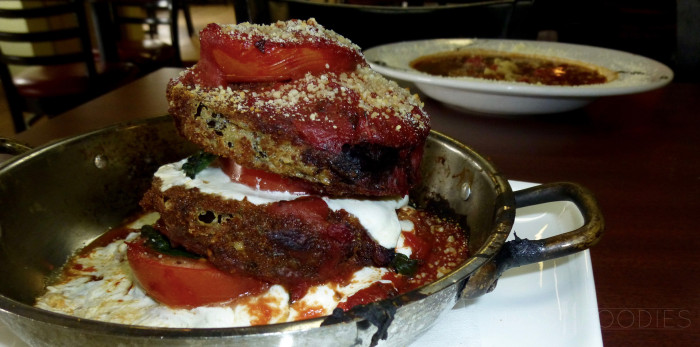 It took Jay some time to get there though. He may have started cooking at four but after a half-century on this earth, this is his first restaurant. Sure, he had a catering business and still does, providing food for everything from movies filmed in Worcester to his and Nancy’s wedding in 2013 to – unknowingly – his own 50th birthday party. Sure, he cooked at Howard Johnson’s near Holy Cross and York Steakhouse in the Auburn Mall as a teenager, but his first career was as an engineer at Digital.
It took Jay some time to get there though. He may have started cooking at four but after a half-century on this earth, this is his first restaurant. Sure, he had a catering business and still does, providing food for everything from movies filmed in Worcester to his and Nancy’s wedding in 2013 to – unknowingly – his own 50th birthday party. Sure, he cooked at Howard Johnson’s near Holy Cross and York Steakhouse in the Auburn Mall as a teenager, but his first career was as an engineer at Digital.
“My mother knew what I was supposed to do before I did. She wanted me to go to Johnson & Wales after high school, because I loved to cook, but it was hot and hard work and I thought I didn’t want to do that for the rest of my life. But my dad is a CPA, and I can swear to you I was not put on this earth to be a CPA. So, I went to engineering school and then to Digital and while I am working there I win a chili contest out of a 100 people.”
That chili was still a ways away from gracing our plates, however. After a decade at Digital, he also explored careers in car and mortgage sales before finally heading to Johnson & Wales and then opening his twisted restaurant.
The name comes from his best friend who told Jay, “You’re always twisted when you come up with these things.” Like his signature shrimp scampi omelet, which he first made following Easter Day brunch in 2010: “One of my servers asked what the special was going to be. I had all this shrimp left over. I was thinking about egg foo young which has a great mouth feel and said, ‘I’m going to do a shrimp scampi omelet.’ We sold nine that day. Then Phantom Gourmet tries it and the rest is history.”
That mouth feel and flavor profiling are the foundation of all Jay cooks, an inductee into Les Dames d’Escoffier in 2014. As approachable as the place and the food is, this is a serious guy loves to play with his food. He sous vides his eggs on weekends and is now evolving from the homemade flatbreads now on the menu to try and create a perfect Neapolitan pizza crust. He tries something new and instantly tries to make it his own. (Sriracha shrimp is the latest customer addiction and Jay is delighted it has caught on.) He’ll also go “out there” and pair things that live and grow together and his customers will usually follow – even if it is, say, a rabbit taco served with a sauce and slaw based on what that animal was eating.
“There isn’t anything I don’t like and won’t explore,” he says. “I try and embrace everything in the area that I can get. If I could get a squirrel or a raccoon locally and find a recipe that comes from the period of the Pilgrims when we ate that? I would do it. The best part about the people who come to this restaurant is they will friggin’ try it too. People say how can you stick to your roots having so many people come in? But I know the people. I know there’s an ass for every seat out there – a restaurant for everybody. I want people to come here because they are happy. I owe everything I do to them.”
And they in turn ask Nancy, “Is he always like this?”
“Chefs open up their lives,” he says. “You come in to my restaurant and this is my life – my bedroom, living room, dining room. And when you run a small family restaurant, customers are my extended family. Nancy asks me all the time, ‘Does everyone need to know all our business?’ But I don’t know any other way.”

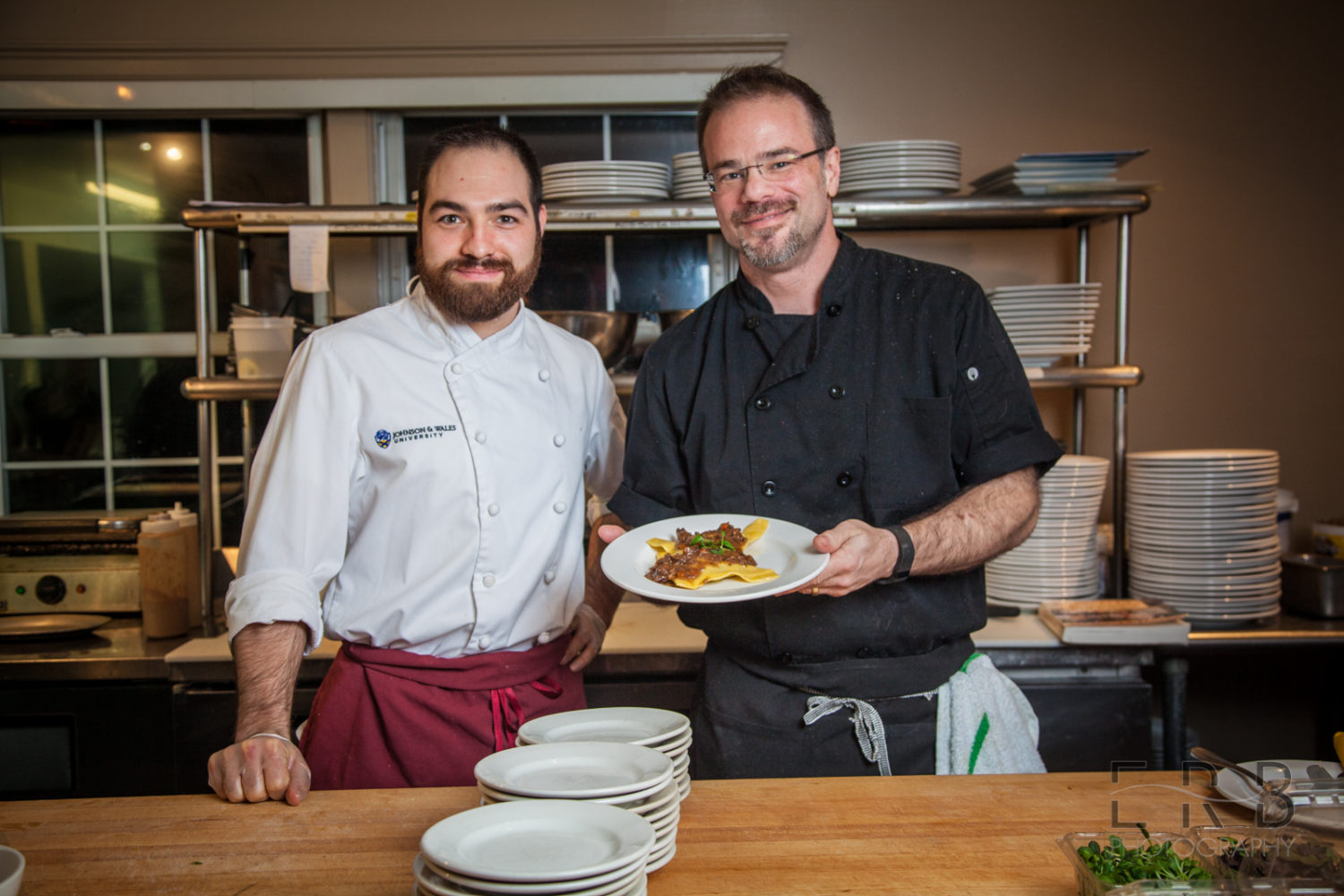
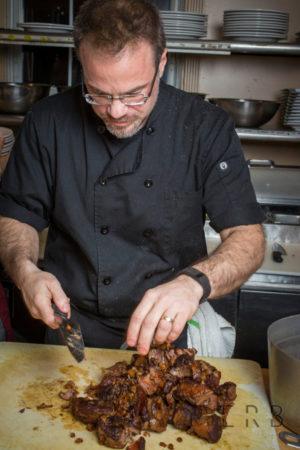
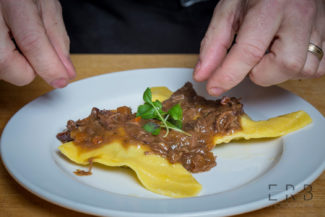 The important thing to Rovezzi is that his pasta is appealing to customers and tastes delicious no matter what. That is true of the instantly familiar dishes like veal saltimbocca, pasta bolognese, and chicken parm, and those that are not, like lasagna filled with winter squashes and maple sausage. The meat next to those caramelized root vegetables and cavatelli? Rabbit. In other words, this is not Rovezzi’s II, a sequel to his father’s beloved Worcester restaurant that closed in 1992.
The important thing to Rovezzi is that his pasta is appealing to customers and tastes delicious no matter what. That is true of the instantly familiar dishes like veal saltimbocca, pasta bolognese, and chicken parm, and those that are not, like lasagna filled with winter squashes and maple sausage. The meat next to those caramelized root vegetables and cavatelli? Rabbit. In other words, this is not Rovezzi’s II, a sequel to his father’s beloved Worcester restaurant that closed in 1992.